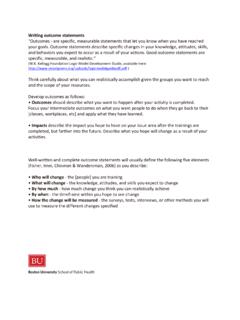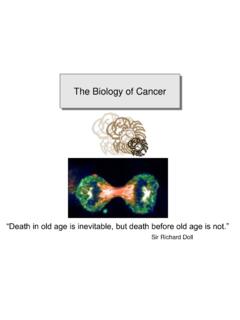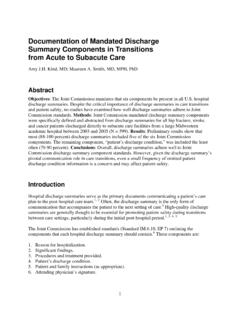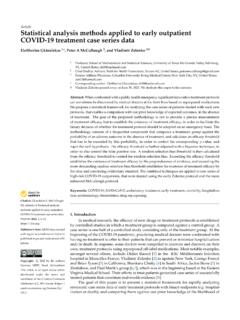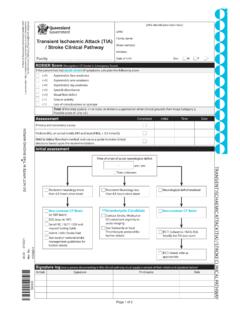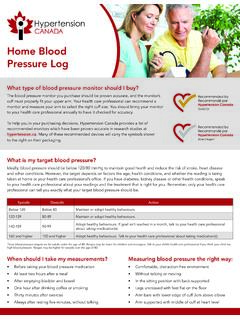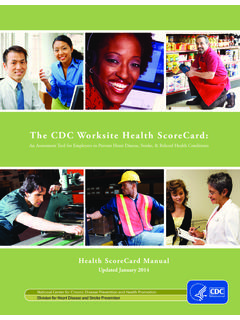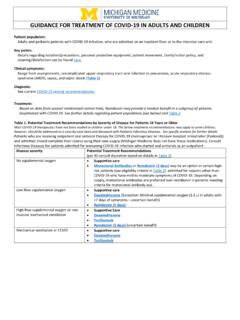Transcription of Preview: Post-class quiz 5 - Clinical Trials Question 1 5 ...
1 Preview: Post-class quiz 5 - Clinical Trials Question 1 5 points What is meant by "randomization"? (Select the one best answer.) A. Selection of subjects at random. B. Randomization is a method of allocating treatment such that each subject has an equal chance of receiving any of the possible treatments. C. Regression to the mean is a common phenomenon in Clinical Trials . D. Biases introduce random outcomes. Question 2 5 points What are the TWO main purposes of randomization? (Select TWO.) A. To eliminate bias in assignment to a treatment group B. To achieve baseline comparability between the intervention and comparison (control) groups, to make the groups being compared similar with respect to known and unknown confounders. C. To avoid the problem of random error. D. To enhance the predictive value of the study. Question 3 5 points Which of the following is/are true about an ideal placebo?
2 (Select all that apply.) A. It is inert. B. It is indistinguishable from the active treatment. C. It allows blinding. D. It minimizes bias when evaluating subjective outcomes. Question 4 5 points What is "blinding" and what is its purpose? (Select one). A. Blinding means you begin with the null hypothesis, and base your conclusions totally on a statistical analysis of the data without any preconceived ideas. B. Blinding refers to equipoise, uncertainty regarding whether a new treatment is effective. C. Blinding means that the subjects and/or investigators do not know which treatment group the subject is in. The purpose is to prevent bias in assessing the outcome. D. Blinding occurs when the results totally disagree with previously published studies. Its purpose is to cause a re-evaluation of the data. Question 5 5 points What is meant by "compliance" in a randomized Clinical trial? (Select one).
3 A. Flexibility in assignment to treatment groups. B. The degree to which study subjects adhere to an assigned treatment protocol. C. An inter-institutional agreement for a multi-center study. D. Benefits for people who enroll in the study. Question 6 5 points What problem results when compliance of subjects is poor in an intervention study? (Select one). A. Confounding will be introduced. B. There will generally be bias away from the "null". C. The effectiveness of blinding will be jeopardized D. If compliance is poor, the two groups will become more alike and the ability to detect true differences in outcome is diminished, , the power of the study is reduced. Question 7 5 points Which of the following is the best explanation regarding the relationship between compliance and "bias toward the null" in a Clinical trial? A. Noncompliance will make the groups appear to be MORE similar, and the apparent strength of association will be diminished.
4 B. Noncompliance will make the groups appear to be LESS similar, and the apparent strength of association will appear to be stronger than it really is. C. Noncompliance has no effect (a null effect) on the relative risk. Question 8 5 points Which statement about blinding in an intervention study is NOT correct? (Select one). A. The purpose of blinding is to reduce bias in determining the outcome. B. The purpose of blinding is to reduce confounding. C. In a double blinded study, neither the subject nor the investigators know which treatment the subject is receiving. D. Blinding can be accomplished by using a placebo. Question 9 5 points Intention-to-Treat analysis of a Clinical trial means which of the following? (Select one). A. Subjects should not be enrolled unless they really intend to take the treatment being tested. This is usually proven during a "run-in" period where their compliance with taking the study drug is tested before the trial begins.
5 B. Anyone randomized into one of the study groups must be included in the final analysis in the group to which they were originally randomized, regardless of whether they adhered to the protocol or not. C. Anyone randomized into one of the study groups should be included in the final analysis, only if they actually took the drug they were assigned throughout the entire study period. D. All subjects must agree to be randomized and to take the treatment of the group they were assigned to. Question 10 5 points Very small randomized Clinical Trials may have which of the following problems? (Select all that apply.) A. The statistical power of the study may be limited if there aren't enough subjects who develop the primary outcome that is being measured. B. Confounding factors may not be equally distributed between groups. C. It is easier to break the blind of smaller Trials and figure out which treatment patients are getting.
6 Question 11 5 points The fact that certain types of people agree to participate in Clinical Trials may affect which of the following? (Select one). A. Validity B. Generalizability C. Randomization D. Sub-group analysis Question 12 5 points Generalizability is more important to a study than validity. True False Question 13 5 points Is Low Dose Aspirin Beneficial? The Physician's Health Study was conducted to test the hypothesis that 325 mg. of aspirin taken every other day would reduce mortality from cardiovascular disease (N. Engl. J. Med. 320:1238, 1989). Male physicians 40 to 84 years of age living in the US in 1980 were eligible to participate. Physicians were excluded if they had a personal history of myocardial infarction, stroke or transient ischemic attack; cancer; current gout; liver, renal or peptic ulcer disease; contraindication to aspirin consumption; current use of aspirin, platelet-active drugs or non-steroidal anti-inflammatory agents; intolerance to aspirin; or inability to comply with the protocol.
7 Eligible subjects who met the inclusion criteria and who successfully completed a run-in phase were randomly assigned to receive aspirin or a placebo. Eventually 22,071 physicians were enrolled; 11,037 were assigned to aspirin, and 11,034 were assigned to placebo. The agents (aspirin and placebo) were identical in appearance and were mailed to the subjects. The recipient's treatment was coded, and neither the subject nor the investigators knew which treatment group a given subject was in. Table 1 below shows the frequency of some risk factors of the subjects at the beginning of the study (baseline). RR is the relative risk of having the risk factor, comparing those who received aspirin to those who received placebo. The p-values that were computed were based on a comparison of the frequency of having the risk factor (or not) among the two treatment groups. Table 1 Aspirin group(N=11,037) Placebo group(N=11,034) RR p-value Cigarette smoking Past 4373 4301 Current 1213 1225 Diabetes mellitus 275 258 Parental history of MI 1420 1432 Cholesterol>260 mg/dl 582 570 Exercise <1/week 2997 3060 Which of the following is an appropriate conclusion that can be drawn from these data?
8 (Select the one best answer.) A. Aspirin did not reduce the risk of diabetes. B. The sample size was too small. C. Based on these data, randomization appears to have been successfully in controlling confounding. D. The frequency of diabetes differed significantly between the two groups since the p-value was less than Question 14 5 points Table 2 below summarizes adverse outcomes in the Physicians Health Study. Use the Cohort Studies worksheet in the "Epi_Tools" Excel spreadsheet to compute the missing risk ratios and p-values for the association between aspirin use and fatal, non-fatal, and total myocardial infarctions. After computing the missing values, which of the following is the most appropriate conclusion? A. The frequency of stroke and upper GI ulcer was significantly greater in the aspirin-treated group. B. Aspirin should be recommended to all adults, because it was associated with a significantly reduced risk of fatal and non-fatal myocardial infarctions no adverse effects.
9 C. Aspirin was associated with a significantly reduced risk of fatal and non-fatal myocardial infarctions, but aspirin users had significantly more bleeding ulcers and other bleeding problems and a borderline significant increase in hemorrhagic strokes. D. Aspirin users had significantly more strokes. Question 15 5 points Since the Physicians Health Study was conducted in men, there were questions about the efficacy of aspirin in women. As a result, the Question about efficacy in women was addressed in another large randomized Clinical trial published in 2005 (Ridker PM, et al.: A randomized trial of low-dose aspirin in the primary prevention of cardiovascular disease in women. N. Engl. J. Med. 2005;352:1293-304.) "Methods: We randomly assigned 39,876 initially healthy women 45 years of age or older to receive 100 mg of aspirin on alternate days or placebo and then monitored them for 10 years for a first major cardiovascular event ( , nonfatal myocardial infarction, nonfatal stroke , or death from cardiovascular causes).
10 Results: During follow-up, 477 major cardiovascular events were confirmed in the aspirin group, as compared with 522 in the placebo group, for a non-significant reduction in risk with aspirin of 9 percent (relative risk, ; 95 percent confidence interval, to ; P= ). With regard to individual end points, there was a 17 percent reduction in the risk of stroke in the aspirin group, as compared with the placebo group (relative risk, ; 95 percent confidence interval, to ; P= ), owing to a 24 percent reduction in the risk of ischemic stroke (relative risk, ; 95 percent confidence interval, to ; P= ) and a non-significant increase in the risk of hemorrhagic stroke (relative risk, ; 95 percent confidence interval, to ; P= ). As compared with placebo, aspirin had no significant effect on the risk of fatal or nonfatal myocardial infarction (relative risk, ; 95 percent confidence interval, to ; P= ) or death from cardiovascular causes (relative risk, ; 95 percent confidence interval, to ; P= ).

